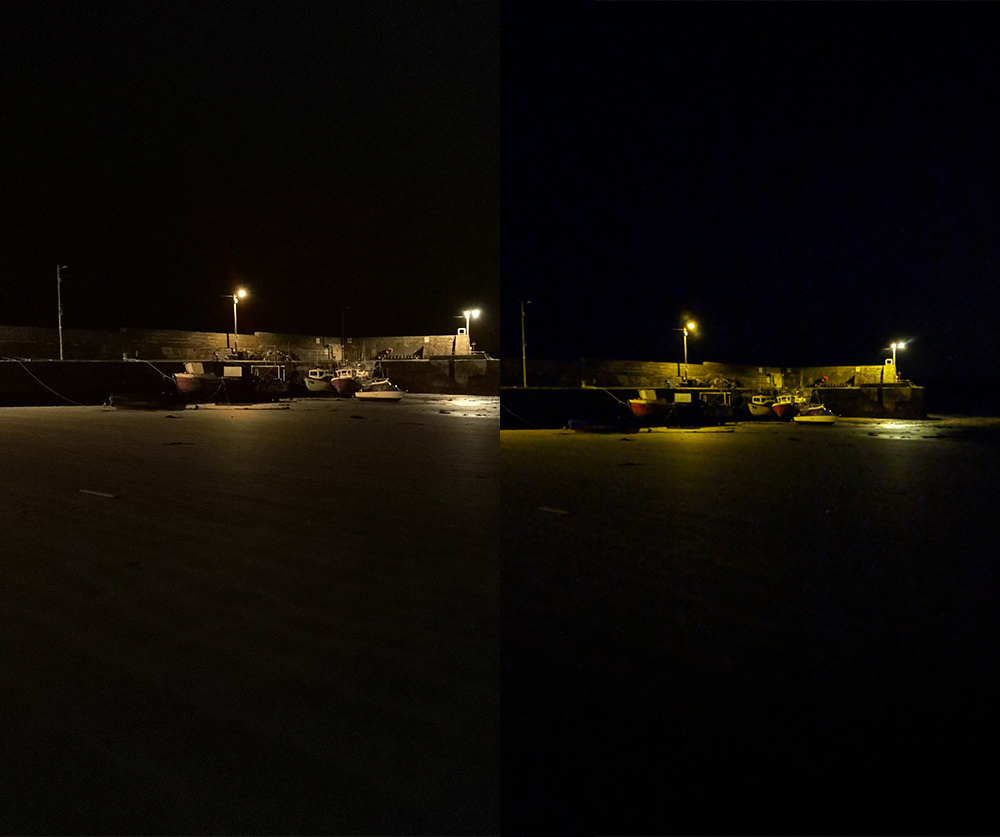The Huawei Mate 10 Pro has two f/1.6 cameras, so it’s no slouch in dark scenes. How far can it’s stellar AI chip push the image though?
I’ve been shooting with the Mate 10 Pro for a week now, and I think it deserves its top-end DXOMark rating. Before Fstoppers releases a full review, I wanted to quickly test out where things could fall apart. I know that it’s able to capture action, has a portrait mode, and a slew of other handy (AI-assisted) features. For now I’m just interested in how it holds up at night.
Below is an image of a laptop sitting on a bed. The only light in the scene is a MacBook and an iPhone, so there's not a whole lot to work with here. As you can see, the AI-assisted image has a lot less noise, but it also emphasizes some artifacts. Nonetheless, there's a clear winner here.

Manually exposed image on the left, AI assisted image (with same exposure) on the right. Exposure at f/1.6, 1/6 s, ISO 800.
Getting Outdoors

Huawei Mate 10 Pro on the left (f/1.6, 1/4 s, ISO 1,250), Google Pixel on the right (f/2, 1/14 s, ISO 4,300).
As you can see from the above image of a harbor at night, the Mate 10 Pro has been able to pull out details in the sand without introducing noise into the sky. You’ll note that when I shoot in these situations, I’ll see a moon symbol in the corner indicating that the smartphone is tweaking the image using neural processing on its Kirin 970 chip. Sometimes it will ask me to hold the camera still while it sharpens the image. In general I’ve found the Mate 10 Pro to get better low light images when left in auto than I have manually changing the exposure settings myself. This is likely proof that the AI is handling a lot more than we’re giving it credit for in low light.
Comparing the harbor image to a Google Pixel, which has been regarded as a low light beast, the Mate 10 Pro takes the win. I think this in an interesting comparison because the Pixel only has one camera (compared to Huawei's dual cameras) and it makes up for that with clever software. I realize now that the Pixel image is a tad out of focus, but there is still more noise and less detail. Luckily I did a second test, and this seems to show an issue that I’ve had with the Mate 10 Pro.

Huawei Mate 10 Pro on the left (f/1.6, 1/4 s, ISO 1,250), Google Pixel on the right (f/2, 1/14 s, ISO 4,300).
In this second beach shot, the pixel doesn’t retain as much detail. You can make out the text on the side of the boat a lot easier on the Mate 10 Pro. However, I’m not a fan of how the light source bleeds into the image so badly. The Pixel is able to handle lens flaring far better, which is important in stark lighting conditions like this.
Raw Images
Here’s a raw file that I grabbed from the Mate 10 Pro and dragged through Photoshop for de-noising, exposure, and color. This is a reasonably dark scene with a lot of contrast in light. I’m still able to bring up the shadows a little bit to flatten things out if I need, but I’m not getting the full AI treatment. There’s no intelligent sharpening, no de-noising, and obviously it won’t be as quick. Nonetheless I can appreciate that the phone allows for manual controls and raw files.
In the end I don’t feel the Mate 10 Pro is the low light camera we’d hoped for, at least in automatic modes. I prefer the how the Pixel seems warmer and vibrant, while the Mate 10 Pro has a certain de-saturation. This must surely be a deliberate effort to avoid the insane noise that some of the Pixel shots have, but in general the Pixel has managed to keep up with the Mate 10 Pro better than I’d thought. When I’ve changed the color profile on the Mate 10 Pro to bring back more saturation, there’s been noise comparable to the Pixel.
What I love about the Mate 10 Pro is how sharp it is compared to other smartphones in similar light conditions. While it's frustratingly difficult to tell what's going on under the hood, this is pretty clearly related to their touted intelligent sharpening. While I'm not a fan of the de-noising, nor the "beautifying" filter (which feels like de-noising your face), in most cases this isn't overdone.
I’m interested to see if there’s a way to bring the Pixel’s HDR+ software to other phones. I wrote about doing it with your iPhone a while back, but the results just weren’t as good. I’d love to see the Mate 10 Pro layer multiple exposures over one another like the Pixel in order to achieve better low light shots.
I’m also excited to see it go up against the iPhone X, and the Google Pixel 2 (both very difficult to get right now). All in all, the Mate 10 Pro is one of the first real AI-powered camera and it’s interesting to see where this will lead technology.












Why don't you get a Sony phone also? My bet is it will perform better than all those mentioned above :)
The use of the Pixel was really to show what other highly regarded smartphone cameras would garner in automatic mode, as a control. I'd love to see some head to head tests between AI and non-AI smartphones!